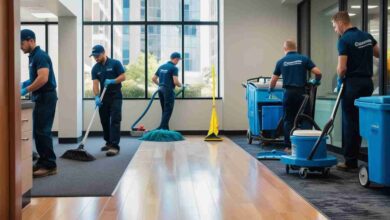Carpet Cleaning Services: How to Use a Carpet Cleaner
A Guide to Using Carpet Cleaner: Professional Carpet Cleaning Tips

Once you’ve chosen a carpet cleaner, it’s time to get hands-on. Here’s a comprehensive guide to using a carpet cleaner for professional-looking results:
1. Preparation: Remove Furniture and Vacuum the Carpet
Start by removing any furniture or large objects from the room. A clear space will allow for a more efficient cleaning process and prevent obstacles that could interrupt the cleaner’s path.
Next, vacuum the carpet thoroughly. Vacuuming removes loose dirt and debris from the surface, which prevents them from turning into mud when combined with the cleaning solution. Failing to vacuum before using a carpet cleaner can lead to poor results, as surface dirt may mix with water and create a mess.
2. Prepare the Cleaning Solution
Most carpet cleaners come with a designated tank for the cleaning solution and water. Follow the manufacturer’s instructions on how much water and solution to use. Avoid using too much detergent, as this can leave a residue that’s hard to rinse out.
Some cleaners are compatible with standard carpet cleaning solutions, while others require specific products to avoid damaging the machine. Always use the recommended cleaning solution, as using the wrong product could void the warranty and lead to unsatisfactory results.
3. Test a Small Patch of Carpet
Before you begin cleaning the entire carpet, it’s wise to test the cleaner and solution on a small, hidden area. This will allow you to ensure that the solution doesn’t cause discoloration or damage. If the area dries without issues, you’re ready to proceed.
4. Start Cleaning: Work in Small Sections
Begin by choosing one corner of the room and working in small, manageable sections. Carpet cleaners often work in two stages: releasing the solution and water mix, then sucking it back up with dirt and debris. Press the trigger to release the solution as you move the cleaner forward, then release the trigger and pull the cleaner back to extract the dirty water. This helps ensure a deep clean and minimizes the amount of water left behind.
5. Overlap Each Pass Slightly
To achieve an even clean, slightly overlap each pass. This prevents streaks and ensures that every inch of carpet is covered. Move at a steady, slow pace for effective cleaning, allowing the machine enough time to agitate the carpet fibers and lift embedded dirt.
6. Rinse the Carpet (If Necessary)
Many carpet cleaners come with a rinse mode or the option to clean with water only. Rinsing helps remove any residual cleaning solution, which can cause the carpet to feel sticky or attract more dirt if left behind. To rinse, fill the cleaner with plain water and go over the carpet again using the same cleaning motion. This step can add drying time but helps ensure a thorough clean.
7. Allow the Carpet to Dry Thoroughly
After cleaning, avoid walking on the carpet until it’s fully dry. Open windows, turn on fans or use a dehumidifier to speed up the drying process. Depending on the type of carpet, humidity levels, and ventilation, drying can take anywhere from a few hours to overnight.
Walking on a wet carpet can push down the fibers and leave imprints, so if you need to use the room, consider laying down towels or sheets as a temporary measure.
8. Perform a Final Vacuum
Once the carpet is dry, do a final vacuum to lift and fluff up the fibers. Vacuuming after a deep clean also helps remove any loose debris that may have been dislodged during cleaning but not extracted by the cleaner.
Additional Tips for Using a Carpet Cleaner
- Use Clean, Filtered Water: Hard water with minerals can leave residue on carpets. Using filtered or distilled water can improve results.
- Don’t Over-Saturate the Carpet: Excess water can penetrate the carpet padding and lead to mold growth. Avoid over-wetting, especially on plush carpets.
- Avoid Heavy Cleaning Products: Overly harsh products can damage carpet fibers and leave a residue. Mild, carpet-safe detergents are best.
- Use a Deodorizing Solution for Pet Odors: For homes with pets, look for a carpet cleaner that includes an odor-fighting component to neutralize smells.
The Benefits of DIY Carpet Cleaning
Learning to use a carpet cleaner is not only budget-friendly but also convenient for regular maintenance. By tackling carpet stains and dirt as they appear, you can keep your carpets in good condition without frequent professional intervention. DIY carpet cleaning also gives you flexibility and control over when and how you clean, allowing for spot treatments on your schedule.
However, while home cleaning is effective, it may still be worth scheduling occasional professional cleanings for a deep, restorative treatment, especially for high-traffic areas or special types of carpeting.
Conclusion
Using a carpet cleaner can be an invaluable tool for maintaining fresh, hygienic carpets. With the right preparation, a careful cleaning process, and a few extra steps for drying and rinsing, you can achieve excellent results on your own. Clean carpets not only improve the aesthetic and air quality of your home but also help extend the carpet’s lifespan. Embrace the DIY approach with confidence.




